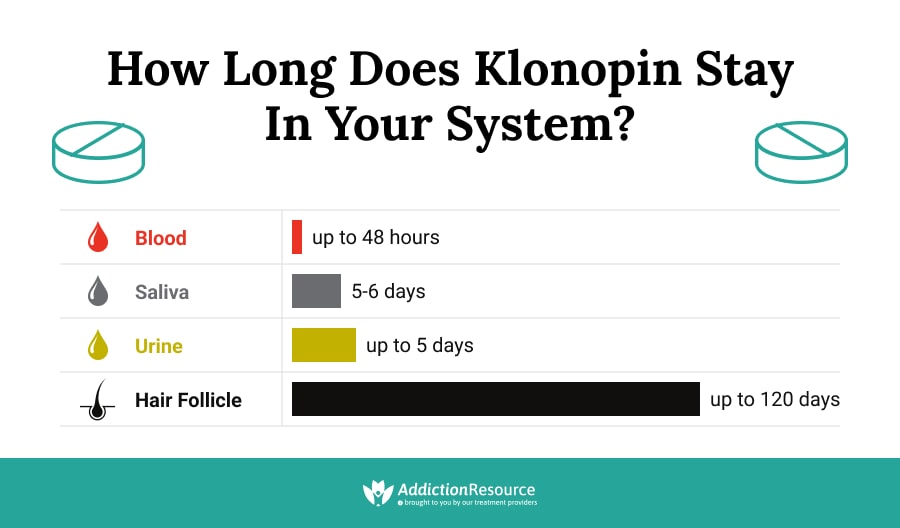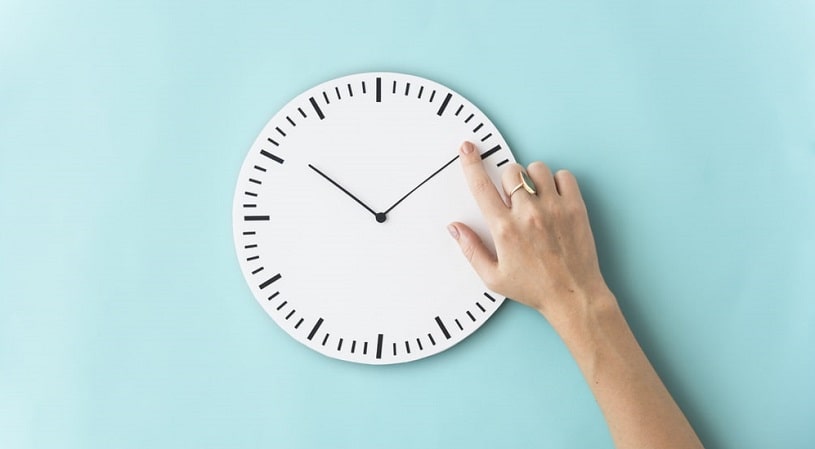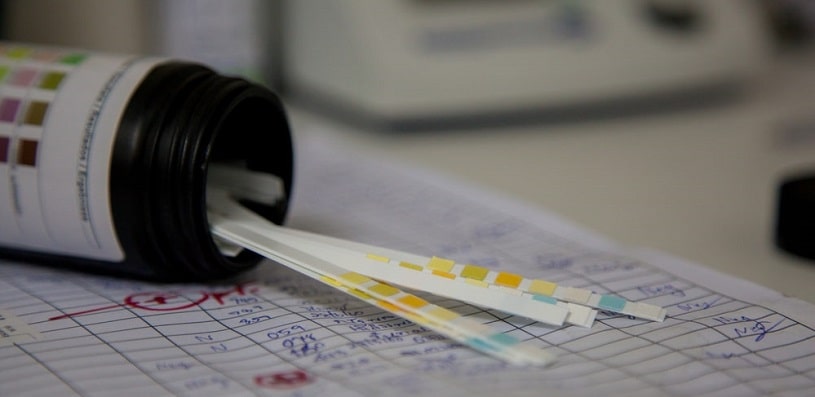Clonazepam is a benzodiazepine sold under the brand name Klonopin. Benzodiazepines are a class of sedatives that have found use in the treatment of several health conditions. These include the treatment of anxiety disorders, sedation, muscle relaxation, seizure disorders, etc. The clonazepam half-life is relatively long; it has an intermediate time of onset and a relatively long duration of action than other commonly used benzodiazepines. Several factors can affect how long a drug test can detect the medication and how long it would take to rid your body of the substance completely.
Table Of Contents:
How Long Does Clonazepam Stay in Your System?
Although clonazepam is a potent benzodiazepine, testing for it is not common. However, various tests can detect the agent with various body samples. Blood, swab, and urine tests are commonly used Klonopin drug tests and can detect the substance for up to 5-6 days after use, while hair tests have a longer detection window, up to four months.
Note that acidic environments can help excrete the substance quicker, reducing the effective window for most Klonopin drug tests.
How Long Does Klonopin Stay in Your Urine?
Urinalysis is the most preferred method for detecting clonazepam and its metabolites, especially in monitoring addiction. Urine tests have cut-off levels of 30 ng/ml and can detect the drug for up to 5 days after intake. Some studies claim that users may test positive for up to 30 days after their last dose. Still, the best way to test negative and stay safe is to say no to clonazepam abuse and potential long-term addiction.
Does Klonopin Stay in Your Blood?
Blood peak concentrations can occur as soon as one hour after intake. Therefore, the best time for a blood test is 1-2 hours after ingestion of a substance dose. However, blood tests can detect the drug a few minutes after intake for up to a few days.
Note that as these Klonopin drug tests using blood samples have a short window of detection and are quite invasive, they are reserved mainly for hospitalized patients.
Can Klonopin Be Detected in Your Hair?
Hair tests provide a long window of detection, up to four months. Thus, hair tests can reveal a lot about the history of abuse and show if the individual has been in contact with the drug in the last 4 months.
We shouldn’t forget that the best time for a hair test is several days after ingestion, as it takes some time for the metabolites to appear in hair segments.
Does Clonazepam Appear in Saliva Specimen?
Saliva tests are a great option in the case of intoxication. That being said, detecting clonazepam and its metabolites in oral fluids using Klonopin drug tests is more difficult compared to other tests. A swab test can detect the drug for 5-6 days after intake, with a cut-off level of 1 ng/ml.

Clonazepam Metabolism
Metabolism is a series of biochemical changes that occur within living cells and involve transforming one substance into another. Clonazepam metabolism occurs primarily within the liver. It is metabolized into several major metabolites, which include 7-aminoclonazepam, 7-acetaminoclonazepam, and 3-hydroxy clonazepam.
People with disorders that affect the liver’s health, such as alcohol-related liver disease, may affect clonazepam metabolism and excretion.
It can increase the clonazepam half-life and therefore the clonazepam duration.
How Long Does Klonopin Take to Work?
The amount of time it takes a pharmacological agent to carry out the intended function after administration is known as the time of onset. Clonazepam has an intermediate onset of action (i.e. somewhere between fast-acting and slow-acting agents). People usually notice the effects within an hour of administering the treatment, typically within 15-30 minutes of taking the medication.
How Long Does Klonopin Last?
The clonazepam duration of action can last between 6 to 12 hours after administration. These long-lasting effects are closely tied to the Klonopin half-life, which ranges between 18.7 and 60 hours.

The half-life of Klonopin suggests that it might take between 5 and 14 days for the drug to leave the system of the user. Clonazepam is a high-potency benzodiazepine and can lead to life-threatening toxicity (especially when mixed with alcohol). The drug has a moderate potential for addiction, especially with chronic use. In other words, one might need up to two weeks to rid their body of the medication due to the long half-life of Klonopin.
Factors That Affect Clonazepam Duration & Excretion
Even with the above values for the Klonopin half-life, it is hard to predict the time it will take to rid your body of the substance completely. In some people, it only takes a few days; for others, it may take weeks. This is due to the clonazepam half-life and other factors such as the individual differences in how the drug is taken and the user’s unique characteristics.
In Addition to the Klonopin Half-Life, the Following Factors Determine How Long It Will Stay in the System:
- Klonopin dosage (which involves the dose, route, frequency, and duration of use)
- Polydrug abuse and addiction (such as also abusing alcohol, other sedatives, stimulants, etc.)
- History of intake
- Age
- Body mass
- Genetics
- Overall health
- Food intake
- Urinary pH
Note that patients with hepatic problems such as alcohol-related liver disease may need more time to clean their system from clonazepam.

How to Successfully Undergo a Benzodiazepine Detox
Benzodiazepines have a significant risk for dependence and addiction, especially long-acting agents such as Klonopin. The relatively long Klonopin half-life means they can potentially remain within the body for weeks, making a detox a long-drawn and potentially uncomfortable process due to the withdrawal symptoms that usually follow the drug’s cessation. Therefore addicts should contact a professional drug rehabilitation center and undergo the treatment process there.
They can offer medical expertise, drugs that help alleviate withdrawal symptoms, and a strong support system. All these increase the chances of the treatment being successful, help successfully reintegrate with society, and teach how to avoid contact with potential triggers which may cause a relapse.
Hope Without Commitment
Find the best treatment options. Call our free and confidential helpline
Most private insurances accepted
Page Sources
- National Center for Biotechnology Information (2021). PubChem Compound Summary for CID 2802, Clonazepam. https://pubchem.ncbi.nlm.nih.gov/compound/clonazepam
- Negrusz, A., Bowen, A. M., Moore, C. M., Dowd, S. M., Strong, M. J., & Janicak, P. G. (2002). Deposition of 7-aminoclonazepam and clonazepam in hair following a single dose of Klonopin. Journal of analytical toxicology, 26(7), 471–478. https://doi.org/10.1093/jat/26.7.471. https://www.ncbi.nlm.nih.gov/pubmed/12423002
- Chèze, M., Villain, M., & Pépin, G. (2004). Determination of bromazepam, clonazepam and metabolites after a single intake in urine and hair by LC-MS/MS. Application to forensic cases of drug facilitated crimes. Forensic science international, 145(2-3), 123–130. https://www.ncbi.nlm.nih.gov/pubmed/15451083
- Tóth, K., Csukly, G., Sirok, D., Belic, A., Kiss, Á., Háfra, E., Déri, M., Menus, Á., Bitter, I., & Monostory, K. (2016). Optimization of Clonazepam Therapy Adjusted to Patient's CYP3A Status and NAT2 Genotype. The international journal of neuropsychopharmacology, 19(12), pyw083. https://www.ncbi.nlm.nih.gov/pmc/articles/PMC5203763
- Basit, H., & Kahwaji, C. I. (2021). Clonazepam. In StatPearls. StatPearls Publishing. https://www.ncbi.nlm.nih.gov/books/NBK556010/
- Griffin, C. E., 3rd, Kaye, A. M., Bueno, F. R., & Kaye, A. D. (2013). Benzodiazepine pharmacology and central nervous system-mediated effects. The Ochsner journal, 13(2), 214–223. https://www.ncbi.nlm.nih.gov/pmc/articles/PMC3684331/
- Griffin, C. E., 3rd, Kaye, A. M., Bueno, F. R., & Kaye, A. D. (2013). Benzodiazepine pharmacology and central nervous system-mediated effects. The Ochsner journal, 13(2), 214–223. https://www.ncbi.nlm.nih.gov/pmc/articles/PMC3684331/

 Authored by
Authored by  Reviewed by
Reviewed by 
